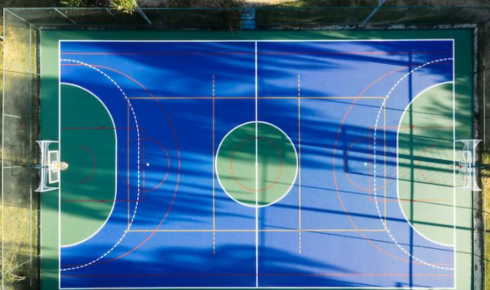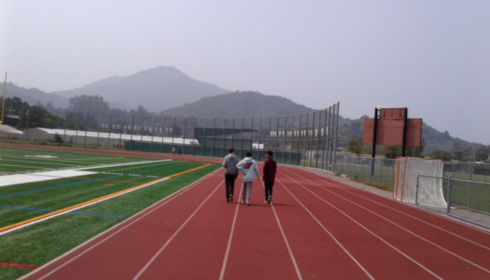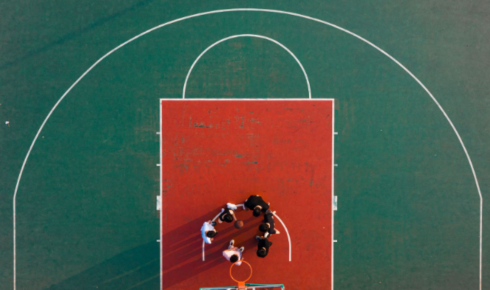
As space becomes more valuable and communities seek cost-effective, high-impact investments, multi-purpose court construction has emerged as the go-to solution for sports infrastructure in India. Whether it’s a school, residential society, college campus, or public park, a well-designed multi-sport court enables multiple games like basketball, tennis, badminton, volleyball, and pickleball to be played on a single surface—saving space, money, and maintenance effort.
This will guide you through the complete process of multi-purpose court planning and execution—from choosing the right dimensions and flooring to selecting durable materials, construction best practices, and long-term upkeep.
1. What is a Multi-Purpose Court?
A multi-purpose court is a versatile sports facility designed to accommodate multiple games on the same surface. It is built with synthetic or acrylic coatings over a concrete or asphalt base and marked with lines for sports such as:
- Basketball
- Tennis
- Badminton
- Volleyball
- Skating
- Pickleball
These courts are particularly useful for schools, universities, housing societies, corporate campuses, and municipal parks, offering year-round access to multiple sports on a single platform.
2. Benefits of Multi-Purpose Court Construction
A. Space Optimization
Instead of allocating separate areas for each sport, multi-use courts allow compact, overlapping layouts with standard markings. This is especially useful in urban areas with limited land availability.
B. Cost Efficiency
From excavation and base construction to flooring and fencing, building a single multi-sport court costs significantly less than constructing individual courts.
C. Ease of Maintenance
Using durable synthetic court flooring reduces maintenance frequency and makes it easier to clean, repaint, or upgrade the court.
D. Inclusivity and Community Use
Multi-sport courts encourage greater participation from all age groups and skill levels. They’re ideal for physical education classes, casual play, and community tournaments.
3. Standard Dimensions for Multi-Purpose Courts
While there’s no one-size-fits-all, a standard multi-sport court is typically 28 meters in length and 15 meters in width, which comfortably accommodates:
- Full-size basketball court
- One or two badminton courts
- One volleyball court
- Space for pickleball, skating, or mini tennis
The court size can be adjusted based on available space and the sports prioritized by the community.
4. Outdoor Sports Flooring Options for Multi-Purpose Courts
Flooring plays a vital role in the performance, durability, and safety of a court. Here are the most preferred outdoor sports flooring options for multi-use facilities in India:
A. Acrylic Synthetic Flooring
This is the most widely used surface in India for outdoor multi-sport courts. Acrylic systems are UV-resistant, weatherproof, anti-skid, and available in vibrant colors.
Advantages:
- Slip-resistant and shock-absorbing
- Suitable for all weather conditions
- Easy to customize for different sports
- Cost-effective and low-maintenance
B. PU (Polyurethane) Flooring
PU is more suited for semi-outdoor or shaded installations. It provides superior cushioning but can be more expensive.
C. Modular Interlocking Tiles
Modular PP tiles are easy to install and ideal for schools or rental courts. However, they may lack the professional performance of poured acrylic surfaces.
D. Asphalt Base with Acrylic Coating
For budget-sensitive projects, asphalt serves as a suitable base under an acrylic surface. Though less durable than concrete, it performs well under moderate use.
5. Step-by-Step Process of Multi-Purpose Court Construction
Creating a multi-purpose court involves detailed planning, skilled execution, and the right materials. Here’s a step-by-step look at the process:
Step 1: Site Assessment
- Soil testing and drainage evaluation
- Measuring available space and setting layout orientation
- Identifying potential usage patterns (school, society, academy)
Step 2: Base Construction
- Earthwork and ground leveling
- Laying a high-quality concrete slab (100–150 mm thickness)
- Ensuring a gentle slope (1%) for water runoff
- Allowing curing time (21–28 days)
Step 3: Flooring Application
- Concrete Primer: For adhesion
- Acrylic Resurfacer: Smoothens base
- Cushion Coat: Improves player comfort
- Color Coat: Adds vibrancy and UV protection
- Line Marking: Customized for each sport
Step 4: Fencing and Lighting
- 10–12 ft perimeter fencing with galvanized mesh
- LED floodlights for evening and night-time use
- Optional spectator seating or player shelters
Step 5: Finishing Touches
- Multi-sport nets and poles
- Wall graphics or branding for schools or academies
- Court signage and usage guidelines
6. Materials Used in Multi-Sport Court Construction
To ensure durability and optimal play experience, high-quality volleyball court materials, tennis net poles, badminton post systems, and basketball hoops are used in combination with synthetic surfacing. Reliable sports infrastructure suppliers offer turnkey solutions with warranties ranging from 5–8 years on surfacing.
Key materials include:
- Concrete M30 grade for base
- Acrylic synthetic coatings for the top layer
- Silica sand for texture and grip
- Weather-proof line paint
- Adjustable pole systems for multiple net heights
- Heavy-duty fencing materials
7. Maintenance and Longevity
A well-built multi-purpose court requires minimal upkeep. Here are key maintenance practices:
- Weekly cleaning with a blower or broom to remove debris
- Annual inspection for cracks or peeling
- Topcoat reapplication every 4–5 years to refresh surface
- Drainage checks before and after monsoon season
- Nets and accessories maintenance to ensure safety
With these simple practices, your court can last over 10–12 years while maintaining performance and appearance.
8. Cost of Multi-Purpose Court Construction in India
The cost can vary based on size, location, material quality, and contractor. Below is an estimated breakdown:
| Component | Estimated Cost (INR per sq. ft) |
| Concrete base | ₹80–₹120 |
| Acrylic surface system | ₹90–₹150 |
| Fencing & lighting | ₹50–₹80 |
| Poles and accessories | ₹30–₹60 |
For a 4200 sq. ft court (approx. 28m x 14m), the total cost can range between ₹6 lakhs to ₹9 lakhs, depending on customization and accessories.
Conclusion
Multi-purpose court construction is not just a trend—it’s a smart investment for the future of sports in India. By building a single, multi-functional space with the right synthetic court flooring and layout design, you can support multiple sports, maximize your budget, and encourage healthy community engagement. From basketball and tennis to badminton and volleyball, a well-executed court becomes a hub for recreation, learning, and competition.
When planned and built by experienced sports flooring contractors, your multi-sport court will not only meet today’s needs but also adapt to tomorrow’s evolving athletic demands


